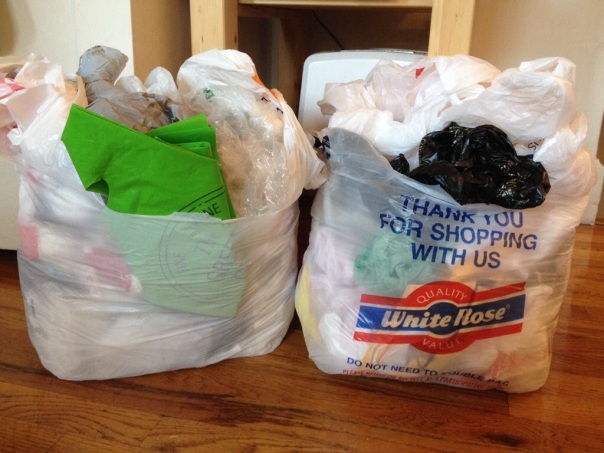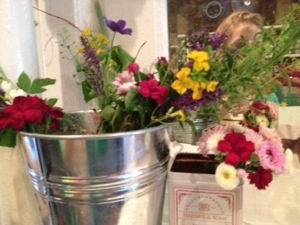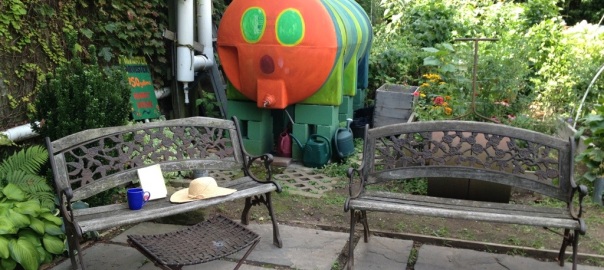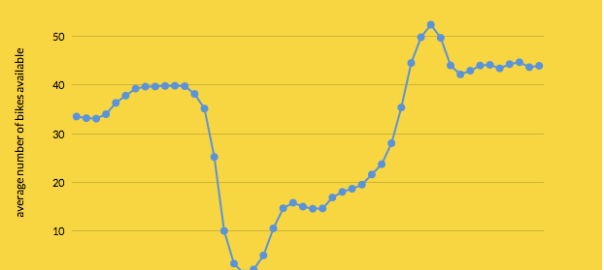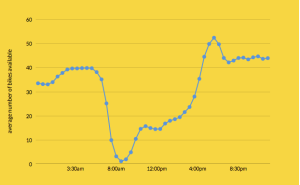Look, oh friends, where I’ve been all morning. Post-shower, post-breakfast, I didn’t have it in me to sit down at the old laptop just yet. I was sleepy, sure, but I was also nervous because I have to return a library book a.s.a.p. — some other patron has requested it, and so I can’t do my usual renew-it-six-times-until-I-get-around-to-it routine — and I’ve been wolfing it down like it’s a cake that’s about to spoil. So I took my green tea to the community garden to camp out for half an hour, to get a few more pages in. You know, until the mosquitoes drove me to insanity. But this is a perfect day, warm but not humid, sunny but not hot, and the mosquitoes must all be napping, and I read and chatted with other gardeners coming in to water their plants and walk their babies for an hour and a half. 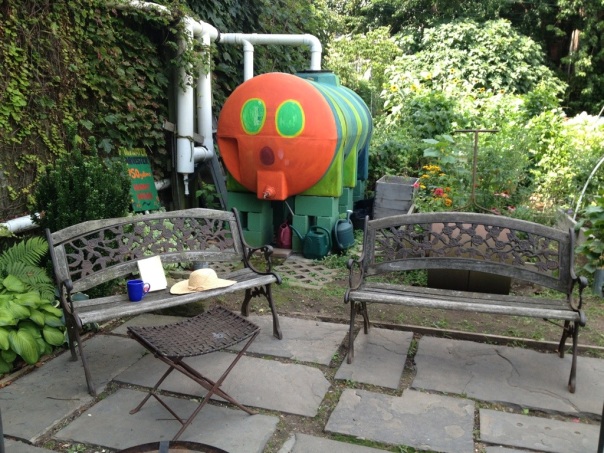
“What are you reading?” asked JoJo, a fellow gardener, a public school teacher and expecting father asked when he came in to water his plot. I showed him my book: The Circle of Simplicity: Return to the good life, by Cecile Andrews, which caught my eye on a recent borrowing spree at the library. (Its first blurb is from the one and only Juliet Schor.) “Does she say you should join a community garden?” he said with a smile. “I think she’s going to,” I replied.
Andrews’ premise is, in a nutshell, that we’re not well, we hard-working Americans. We’re tired and cranky and lonely and sick and divorced and a little desperate. And it’s because we’ve been sold on the idea that we should follow a certain formula: success in work + success in building a little castle = happiness and success in life. But the big TVs and cars only separate us from other people, and working to buy those things separates us from our true gifts, passion, and drains our energy for life. Not to mention the toll this all takes on the poor planet, which we’re squeezing dry with all our successful widget-producing and comfortable, affluent living.
Re-thinking your priorities, finding your own truths about what you want in life, and connecting with other people— at the grocery store, on your block, at the playground or church or temple — are some of the big-picture remedies she suggests. The more involved you are in authentic relationships, and the more time you spend doing things that give you pleasure, fulfillment, and purpose, the less time you spend numbed out in front of mediocre television (this book was written in 1997, before TV got a lot better) or shopping, worried that your clothes aren’t good enough yet.
A lot of her anecdotes and analyses might feel familiar to a reader who is already exploring these ideas, but she’s very astute at identifying subtle factors: for example, the way wide streets and the fact that we don’t build front porches anymore make it harder for us to have casual contact with our neighbors. Even in New York, where we live in close proximity, many neighborhoods have seen their hangout cafes, or their community-based grocery stores, replaced by big chains. This book will make an outstanding introduction for anyone interested in just exploring their own doubts and questions about their lifestyle for the first time. In fact, I think it makes an excellent read to start with before jumping into Juliet Schor’s Plenitude (check out Treehugger’s recap here), which is less philosophical but gets down to the brass tacks of sustainability and personal economics.
“Simplicity Circles,” a cross between a book-club and a consciousness-raising group, are part of Andrews’ vision toward helping people change their lives. You can’t change without support and community, she says, and you can’t have community without laughter. That’s partly what I hope to do with this blog — laugh at the foibles that come along when trying to make deliberate change, and to share them with others. I’m thinking about putting a little note inside the book when I return it to the library, so maybe the person who’s waiting for it so eagerly will invite me to join theirs.
UPDATE: I picked up the book again over a late lunch, and came across this spot-on description of gardening:
“My whole life experience has taught me that the intellectual life is superior to the physical life, particularly the life of nature. So it wasn’t until just a few years ago that I started gardening. I had always thought that the reason you gardened was to have flowers around, so it would look beautiful. I didn’t realize that gardening was an end in itself.
In fact, I was astonished to see how much I loved weeding—it was almost a mystical experience. I would start weeding and become totally absorbed. Down on my knees among the tall flowers and plants, I felt different, I felt expanded. I wouldn’t want to stop, even though I knew that, after all that bending, I probably wouldn’t be able to walk the next day.”





